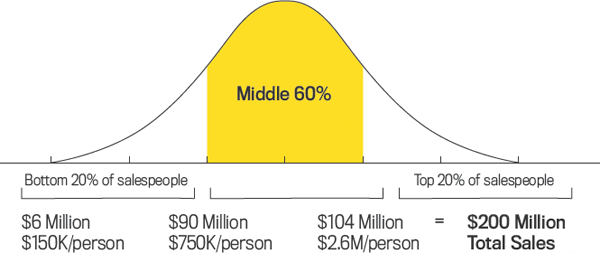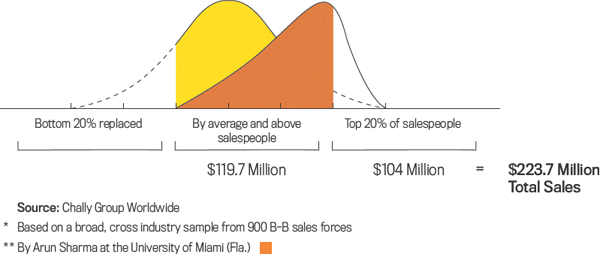

Conventional wisdom says that the Internet is making sales jobs obsolete, that those sales teams who remain consist primarily of extroverted go-getters and that selling is an art that’s only measured at the end of each fiscal quarter. Unfortunately, conventional wisdom is dead wrong. Scientific research into what actually works—and what doesn’t—inside today’s most effective selling environments reveals that the conventional wisdom about selling is not just incorrect, but a recipe for failure. Here are the four most important things that CEOs need to know about successful selling into today’s unconventional business world.
There is no question that the Internet has changed the way companies interact with customers. Customers can now get product information at the same time as the sales rep, not just about the sales rep’s offerings, but the offerings of all of the rep’s competitors. As a result, customers can now configure and order products and manage the shipment of those products across the web without the need of a sales professional.
Conventional wisdom says that this power, in the hands of the customer, should make sales professionals less important. But that turns out not to be the case. Research into how companies are deploying salespeople suggests that the Internet has created a net increase in the demand for sales professionals, but with this proviso: the individuals who thrive in today’s environment must possess a different and more extensive skill set.
Take, for example, the travel industry, which once provided employment for tens of thousands of travel agents whose main responsibility was booking airline tickets. Today, of course, most people make their plane reservations directly online, eliminating the need for professional help. However, despite the commoditization of its key product, demand for travel agents remains high, according to the U.S. Bureau of Labor Statistics. Rather than making travel agents obsolete, the Internet has created a new market for more complex services (such as luxury travel) to a more sophisticated class of customers. What was once a clerical sales job evolved into a solution-based sales job.
Similarly, many once believed that the Internet would mitigate or eliminate the need for a sales force to sell computer technology. With a wide variety of computer hardware, software and services available online, companies would simply find whatever computer products they wanted for the lowest price possible. However, while relatively simple products, like personal computers, became commodities, the Internet paradoxically began to create a demand for a higher level of sales activity.
Because basic computer’s power became so cheap, companies discovered they could use that power in ever-more-complex and interesting ways. Doing so, however, often required expertise that the company itself did not have, or lacked the ability (or interest) to obtain. Computer firms like IBM thus began to focus on selling and providing services to help companies harness all that cheap computing power.
A key insight explaining why sales as a profession will not only survive, but become increasingly critical is realizing that a purchase (especially in the business-to-business world) is first of all a decision to outsource. If the purchasing company decided to in-source that product or service, they would have a manager overseeing that function. As a replacement for that internal control, sales professionals are often required to act as “surrogate managers” to the companies they serve. In these high-profile markets, customers care less about salespeople with the “traditionally trained sales skills” than their general management savvy and ability to understand business, as well as their effectiveness at customer advocacy to protect their interests within the vendor organization.
Similar shifts inside almost every industry can be observed. In fact, the Internet has made the role of the sales professional more important than any other element of the sales environment, including price.
Conventional wisdom says that the best sales professionals are hard-driving mavericks who can drum up business, develop opportunities and close deals like crazy. If you get enough of these types on board, you can point them at opportunities anywhere and everywhere, and they’ll make money for your firm.
Though frequently accepted inside the executive suite, that theory is deeply flawed. The most successful companies tend to have organizations that are extremely complex, and comprise anywhere from two to five distinct sales and customer facing roles. (For a sample sales specialty map, visit https://chiefexecutive.net/SalesEffectiveness.)
While many of those job roles have a superficial similarity (many involve “selling” for instance), the types of activities and competencies that prove successful vary widely. Research, including more than 400 validation (actuarial) studies, has identified the distinct characteristics, skills and competencies needed for success in different types of sales roles that specifically distinguished strong from poor performers in the same roles.
More critically, the strengths and weaknesses of very top performers made them specialist “savants” limiting the ultimate flexibility. This helps explain why the best salespeople often fail in management, just as the best surgeons don’t make the best hospital administrators, or the best artists don’t run the top museums.
The research also demonstrates that while some roles may demand some of the stereotypical “go-getter” sales behavior, other roles are just as likely to favor employees with less showy strengths, like strong analytical skills, the ability to empathize with customer problems, or a deep understanding of complex business issues. Because of this, few, if any, individuals are likely to be successful in more than a few of these many roles.
This is important, because many companies, when faced with market changes or difficult economic times, tend to pluck top performers from their jobs and reassign them to roles with markedly different requirements, assuming they will flourish in their new position. However, the characteristics that make an individual successful in one role may not only provide little preparation to help them succeed in another, it often actually hinders their chances.
Failure to understand this can have devastating consequences. In most organizations, top producers generate more than half of all sales revenue. And, statistically speaking, top producers are rare, representing one out of every 15 qualified applicants and only one in every five people hired. Moving such valuable and rare resources into roles where they’re unlikely to be successful is a recipe for lost opportunities, lost revenue, and unhappy employees.
The specialization of sales roles suggests that, rather than reassigning top performers to new roles in response to economic challenges, CEOs (and the sales management working under them) should keep the top 20 percent of high producers for each role in place. Meanwhile, other personnel should be moved into specific sales positions based upon their individual skill sets and competencies compared with the requirements of that role.
The best analogy for sales force alignment is perhaps that of sound financial investing. Companies should keep their top producers, which offer a high return on investment, but also diversify by adding individuals with growth potential to their organization, for some of these individuals will ultimately generate profit.
Conventional wisdom is that top sales professionals don’t need anything other than a high school diploma—if that—in order to sell. While they might need some technical training to sell a particular product, and may need to learn some sales skills, what’s important is that they have the right personality.
This misconception has cost companies dearly. U.S. firms alone spend $7.1 billion on sales training every year, and in some industries, the costs associated with the development of a single salesperson can be in excess of $100,000. With expenses that high, it can take as long as two years before any profit is realized from those new sales hires.
Yet, as we saw above, selling is not a generalist profession any longer, but is differentiated and specialized, which puts an enormous burden on companies to bring their sales personnel up to speed, if they’re hired simply because they seem to have the “right personality.”
As an alternative to the very expensive process of training sales professionals from scratch, an increasing number of firms are hiring people who have taken sales courses and programs inside colleges and universities. Such individuals enter the job market already trained in basic business concepts, like profit and loss analysis, information technology, account management, relationship building skills, market analysis and product/service promotion and distribution, as well as specific expertise in key business disciplines, like supply chain management.
Obviously, it is greatly to the advantage of the hiring firm when sales job candidates already understand the basics of selling and have already identified the areas where they’re most likely to be successful. There are now more than 50 sales-oriented business curricula across the globe producing exceptional graduates who “ramp up” 50 percent faster than the average candidate, and are 35 percent less likely to turnover. Moreover, these graduates already have demonstrated the aptitude and desire to work in sales, and are therefore more focused and in-tune with the numbers and the processes designed to get the numbers.
While these programs differ in the details of their approach, all seek to help train sales specialists who can combine an expert knowledge of sales strategy with a parallel expertise in a targeted field of business. The programs benefit both business and students by aligning educational goals with the realities of the employment market. Today’s sales profession is moving towards a training model where universities provide the groundwork upon which corporations build specific specialties that are needed inside that sales environment.
Sales consultants often suggest that companies study the techniques of the “A” players—the top 20 percent—to identify the most effective techniques and use that knowledge in training the rest of the team. But the math doesn’t work.
The charts below assume a typical 200-person sales force for a company with annual sales of $200 million. Contrary to the popular “80/20” rule, the top 20 percent performers actually produce 52 percent of top-line revenue. Furthermore, even though sales grew by 5 percent by training the middle, the result was limited: $94.5 million (x) 5 percent, or $4.5 million.
Applying Total Quality Management (TQM)—a data-driven methodology for using standards, measurements and repeatable processes to find and eliminate the sources of sales failure—reveals the real problem: the bottom 20 percent who are losing money. Reassigning or replacing the bottom 20 percent with just “average” sales people will increase production by a minimum of 9 percent. Training the rest of the sales force to get a 5 percent gain now brings an additional $5.7 million. And TQM can be taken even further by studying what type of people fail and not hiring them in the first place.
The following charts demonstrate the application of sales improvement techniques at a hypothetical company with 200 salespeople and $200 million in sales.
Contrary to conventional 80/20 rule wisdom, the top 20 percent of sales performers actually produce 52 percent of top-line revenue. A commonly proposed improvement method is to study techniques of these top 20% sales representatives and train the middle 60% with those techniques…

…but improving the performance of the middle 60% of the sales force by 5 percent only represents a meager 2.25% improvement in sales.

Reassigning or replacing the bottom 20% of salespeople with average or above-average performers will increase sales to $223.7 million—for an 11.85 percent performance gain (shown below). Next, train the rest of the sales force and get an additional 5% gain.




Chief Executive Group exists to improve the performance of U.S. CEOs, senior executives and public-company directors, helping you grow your companies, build your communities and strengthen society. Learn more at chiefexecutivegroup.com.
0

1:00 - 5:00 pm
Over 70% of Executives Surveyed Agree: Many Strategic Planning Efforts Lack Systematic Approach Tips for Enhancing Your Strategic Planning Process
Executives expressed frustration with their current strategic planning process. Issues include:
Steve Rutan and Denise Harrison have put together an afternoon workshop that will provide the tools you need to address these concerns. They have worked with hundreds of executives to develop a systematic approach that will enable your team to make better decisions during strategic planning. Steve and Denise will walk you through exercises for prioritizing your lists and steps that will reset and reinvigorate your process. This will be a hands-on workshop that will enable you to think about your business as you use the tools that are being presented. If you are ready for a Strategic Planning tune-up, select this workshop in your registration form. The additional fee of $695 will be added to your total.

2:00 - 5:00 pm
Female leaders face the same issues all leaders do, but they often face additional challenges too. In this peer session, we will facilitate a discussion of best practices and how to overcome common barriers to help women leaders be more effective within and outside their organizations.
Limited space available.

10:30 - 5:00 pm
General’s Retreat at Hermitage Golf Course
Sponsored by UBS
General’s Retreat, built in 1986 with architect Gary Roger Baird, has been voted the “Best Golf Course in Nashville” and is a “must play” when visiting the Nashville, Tennessee area. With the beautiful setting along the Cumberland River, golfers of all capabilities will thoroughly enjoy the golf, scenery and hospitality.
The golf outing fee includes transportation to and from the hotel, greens/cart fees, use of practice facilities, and boxed lunch. The bus will leave the hotel at 10:30 am for a noon shotgun start and return to the hotel after the cocktail reception following the completion of the round.